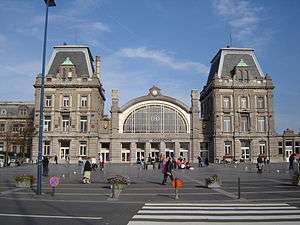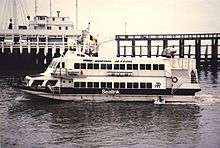Oostende railway station
Oostende | |
|---|---|
|
| |
 | |
| Location |
Natiënkaai 8400 Oostende |
| Coordinates | 51°13′44″N 2°55′33″E / 51.22889°N 2.92583°ECoordinates: 51°13′44″N 2°55′33″E / 51.22889°N 2.92583°E |
| Owned by | National Railway Company of Belgium |
| Line(s) | 50A, Kusttram |
| Platforms | 6 NMBS |
| Tracks | 11 NMBS |
| History | |
| Opened | 1838 |
| Rebuilt | 1913 |
| Electrified | 3Kv DC overhead on NMBS and 600v DC overhead on the Kusttram. |
Oostende railway station (IATA: ZGJ) is located in Ostend in West Flanders, Belgium. The first station in Ostend was opened in 1838 during the reign of Leopold I of Belgium on the former Belgian railway line 62 to Torhout and is now a supermarket. The NMBS station was opened in 1913 during the reign of Albert I of Belgium. The station is designed to connect trains and ferries and is built with Scottish Granite, Bluestone from Soignes and Limestone from Euville. It is constructed in a classical style of architecture inspired by the French architect from the 18th Century François Mansart and the Louis XVI of France style.
The station was served by a daily Thalys high speed service to Paris between 1998 and 31 March 2015.[1]
Train services
The Ostend station is a major hub on the NMBS network with frequent InterCity trains serving Brugge railway station, Gent-Sint-Pieters, Brussels South and Liège-Guillemins on Belgian railway line 50A. Connecting InterCity trains run to Antwerpen and Kortrijk.
The station is served by the following services:[2]
- Intercity services Ostend - Bruges - Gent - Brussels - Leuven - Liege - Eupen
- Intercity services Ostend - Bruges - Gent - Sint-Niklaas - Antwerpen
- Intercity services Ostend - Bruges - Kortrijk - Zottegem - Brussels - Brussels Airport
| Preceding station | NMBS | Following station | ||
|---|---|---|---|---|
| Terminus | IC 01 | toward Eupen |
||
| Terminus | IC 02 | toward Antwerpen-Centraal |
||
| Terminus | IC 23 | toward Brussels National Airport |
Kusttram
Ostend is a major hub on the Kusttram which is the coastal tramway ran by De Lijn.
Cycling
To encourage cycling the station has an extensive amount of cycling racks.
Former Ferries
Regie voor Maritiem Transport used to run services connecting into Dover Western Docks or connecting into trains to London Victoria or London Charing Cross stations, ran by Southern Region of British Rail which terminated their service in 1994. In the past one could take a ferry to Folkestone Harbour transferring to connecting boat trains to the London Victoria or London Charing Cross stations.

